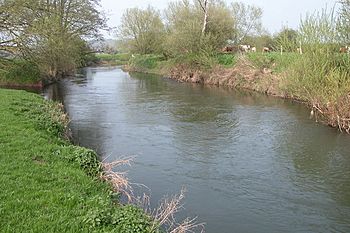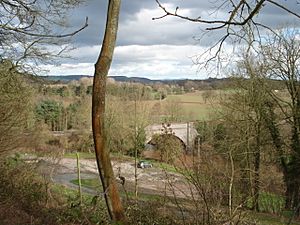River Lugg facts for kids
Quick facts for kids River Lugg |
|
|---|---|

The Lugg at Hampton Bishop
|
|
| Native name | Afon Llugwy |
| Country | Wales, England |
| Counties | Radnorshire, Herefordshire |
| Settlements | Llangynllo, Presteigne, Leominster, Hope under Dinmore, Bodenham, Marden, Lugwardine |
| Physical characteristics | |
| Main source | Llangynllo Radnor Forest, Radnorshire, Wales 497 m (1,631 ft) 52°21′29″N 3°12′20″W / 52.35806°N 3.20556°W |
| River mouth | confluence with River Wye Mordiford, Herefordshire, England 46 m (151 ft) 52°01′52″N 2°38′10″W / 52.03111°N 2.63611°W |
| Length | 72 km (45 mi) |
| Basin features | |
| Tributaries |
|
The River Lugg (called Afon Llugwy in Welsh) is a river that starts high up in the hills. It begins near Llangynllo in Radnorshire, Wales. The river then flows through the town of Presteigne, which is on the border between Wales and England.
After that, the River Lugg enters Herefordshire, England. South of Leominster, another river joins it. This joining river is called the River Arrow, and it's a smaller stream that flows into a larger one, known as a tributary. The River Lugg then meets the River Wye at a place called Mordiford. This meeting point, where two rivers join, is called a confluence. Mordiford is about 9 miles (14 km) downstream from Hereford. The River Lugg's name comes from an old Welsh word meaning "bright stream."
Contents
Exploring the River Lugg
The River Lugg is a great place for outdoor activities. It's popular with people who enjoy canoeing. Canoeists have the right to travel along the river. However, if you try to canoe from Leominster to Hereford, you might find many fallen trees blocking your way.
Fishing in the River Lugg
The River Lugg is also known as a good place for fishing. Many different types of fish live in its waters. It's a favorite spot for anglers, which are people who fish with a rod and line.
The River's Environment
The River Lugg is home to many important plants and animals. Some of these creatures are protected, meaning they are special and need help to survive. These include crayfish, otters, salmon, and lampreys. The river's banks and the gravel at its bottom are important parts of their habitat.
Protecting the River Lugg
In late 2020, a part of the river near Kingsland in Herefordshire was damaged. This area was a SSSI, which means it's a very important place for nature. Trees were cut down, gravel was removed from the riverbed, and the river's natural curves were straightened. All the plants in the area were dug up. This work was done without permission.
Organizations like the Environment Agency, Natural England, and the Forestry Commission stepped in to stop further damage. The Herefordshire Wildlife Trust explained that these changes would harm wildlife living downstream. They also asked that the person responsible be held accountable.


